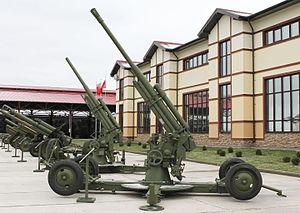| 85 mm air defense gun M1939 (52-К) | |
|---|---|
 | |
| Type | Anti-aircraft gun Tank gun |
| Place of origin | Soviet Union |
| Service history | |
| Wars | World War II |
| Production history | |
| Produced | 1939-1945 |
| Specifications | |
| Mass | combat: 4,500 kg (9,921 lbs) travel: 4,500 kg (9,921 lbs) |
| Length | 7.05 m (23 ft 2 in) |
| Barrel length | 4.7 m (15 ft 5 in) 55 Calibers[1] |
| Width | 2.15 m (7 ft 1 in) |
| Height | 2.25 m (7 ft 5 in) |
| Crew | 7 |
| Shell | 85×629 mmR[2] |
| Shell weight | 9.2 kg (20 lb 5 oz)[3] |
| Caliber | 85 mm (3.34 in) |
| Breech | Vertical sliding-wedge |
| Recoil | Hydro-pneumatic[1] |
| Carriage | 2-axle and 4-wheeled with outriggers |
| Elevation | -3° to 82° |
| Traverse | 360° |
| Rate of fire | 10-12 rounds per minute |
| Muzzle velocity | 792 m/s (2,598 ft/s) |
| Effective firing range | 10,500m (34,448 ft) (vertical range) |
| Maximum firing range | 15.65 km (51,127 ft) (9.72 mi) |
The 85 mm air defense gun M1939 (52-K) (Russian: 85-мм зенитная пушка обр. 1939 г. (52-К))[4] was an 85 mm (3.3 in) Soviet anti-aircraft gun, developed under guidance of leading Soviet designers M. N. Loginov and G. D. Dorokhin. This gun was successfully used throughout the Second World War against level bombers and other high- and medium-altitude targets. In emergencies they were utilized as powerful anti-tank weapons. The barrel of the 52-K was the basis for the family of 85-mm Soviet tank guns. After the war some 52-Ks were refitted for peaceful purposes as anti-avalanche guns in mountainous terrain.
Virtually every country behind the Iron Curtain received this gun after World War II for their air defense. In the Soviet Union itself, these guns were largely superseded by the 100 and 130 mm guns.
- ^ a b Foss, Christopher (1977). Jane's pocket book of towed artillery. New York: Collier. p. 249. ISBN 0020806000. OCLC 911907988.
- ^ "78- MM CALIBRE CARTRIDGES". quarryhs.co.uk.
- ^ Chamberlain, Peter; Gander, Terry (1975). Anti-aircraft guns. New York: Arco Pub. Co. p. 63. ISBN 0668038187. OCLC 2000222.
- ^ "KS-12 KS-12A 85mm M1939 M1944 anti-aircraft gun cannon technical data sheet specifications pictures | Russia Russian army light heavy weapons UK | Russia Russian army military equipment vehicles UK". Archived from the original on 8 December 2022. Retrieved 28 April 2017.